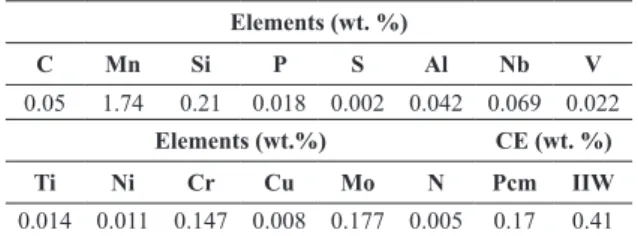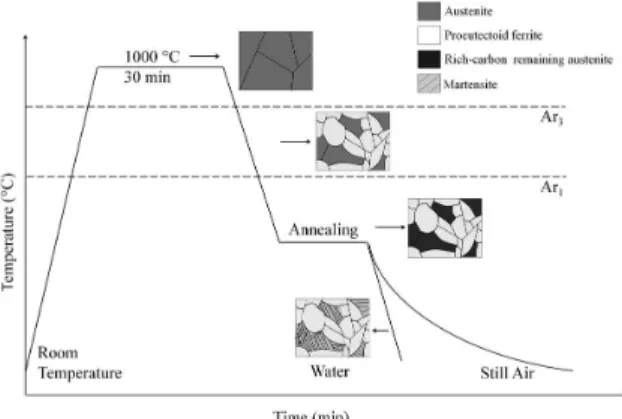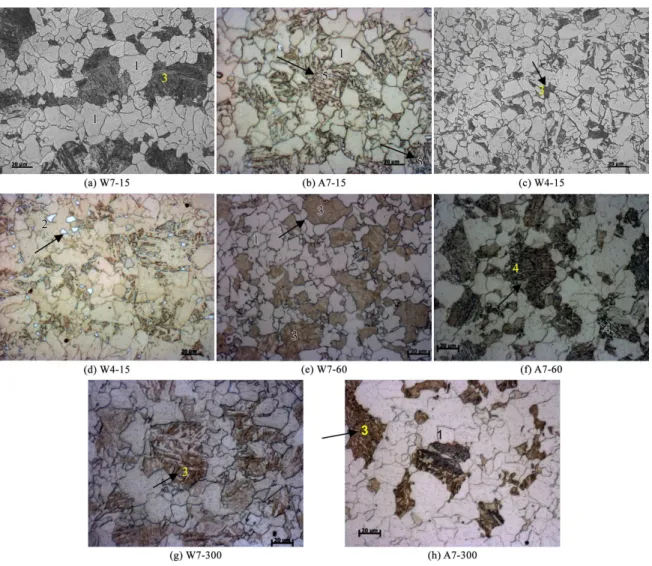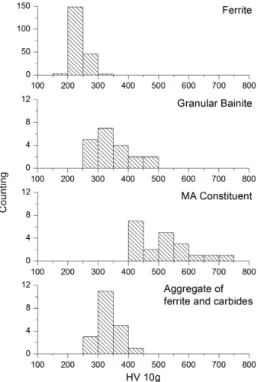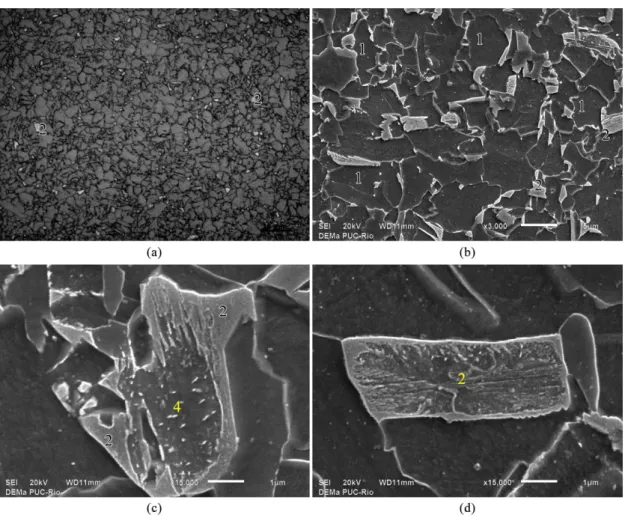*e-mail: rafael.engmet@gmail.com
1. Introduction
API steels are produced by thermomechanical controlled processing (TMCP) followed by interrupted accelerated cooling (IAC) above Ms or by TMCP without accelerated cooling using a careful alloy design and inishing rolling temperature in the dual phase ield, where the main hardening mechanisms are grain reining and precipitation. Steels rolled in the dual phase ield can present a complex and multiphasic microstructure. However, signiicantly transformations in microstructure occurs when the steel is submitted a thermal cycle with peak temperature of 1000 °C, typical of several situations during service such as hot bending.
In the dual phase domain the steels present the formation of proeutectoid ferrite and part of austenite remains untransformed (remaining austenite). Depending on the carbon content and inal cooling rate, the remaining austenite can be transformed into different phases and constituents.
This work studies the microstructural evolution of an API 5L X80 (Nb Cr Mo V) steel obtained by heat treatments at laboratory scale without strain effects. This alloy was
austenitized and submitted to annealing followed by cooling in water or still air. Temperature and time were the variables in these heat treatments of annealing. The effect of the carbon content on the phase transformation of the remaining austenite was studied. The microstructural comparison was based on morphological aspects and in the correlation between the microhardness values of the MA constituents and martensite islands and its carbon contents.
2. Literature Review
In intercritical inishing rolling the coexistence of proeutectoid ferrite and remaining austenite results in an inhomogeneous microstructure1,2. The strain of austenite-ferrite mixture and the subsequent transformation of the remaining austenite and proeutectoid ferrite have received very little attention3. The strain in the dual phase ield increases the total area of the austenite/ferrite interface that raises the rate of carbon and manganese diffusion during the ferrite growth4. The plastic strain of austenite inluences the kinetics of ferrite formation5. In general, the austenite strain increases the Ae
3
Formation of Microphases and Constituents from Remaining Austenite Decomposition in
API X80 Steel Under Different Processing Conditions
Rafael de Araujo Silvaa*, Luís Felipe Guimarães de Souzab,
Eduardo Valencia Moralesc, Paulo Rangel Riosd, Ivani de Souza Botte
aDepartamento de Engenharia de Materiais – DEMa, Universidade Federal de São Carlos – UFSCar,
Rod. Washington Luiz, Km 235, São Carlos, SP, Brazil
bDepartamento de Engenharia Mecânica, Centro Federal de Educação Tecnológica Celso Suckow da
Fonseca – CEFET, Av. Maracanã, 229, Bl E, 506, Maracanã, CEP 20271-110, Rio de Janeiro, RJ, Brazil
cDepartamento de Física, Universidad Central de Las Villas, 54830, Santa Clara, VC, Cuba dUniversidade Federal Fluminense – EEIMVR, Av. dos Trabalhadores, 420,
CEP 27255-125, Volta Redonda, RJ, Brazil
eDepartamento de Engenharia Química e de Materiais – DEQM,
Pontifícia Universidade Católica do Rio de Janeiro – PUC-Rio, Rua Marques de S. Vicente, 225, Gávea, CEP 222541-900, Rio de Janeiro, RJ, Brazil
Received: August 8, 2014; Revised: April 7, 2015
The main goal this work is to evaluate the occurrence of the constituents and microphases observed in as-received API X80 pipe through the microstructures transformed from rich-carbon remaining austenite obtained via heat treatments. These heat treatments comprised austenitization at 1000 °C for 30 minutes, followed by annealing at 700 °C, 623 °C, 542 °C and 462 °C for 15, 60 and 300 minutes and then cooling in water or still air. The effects of the increase in annealing parameters were: 1) the increase of microhardness values of the MA constituents and martensite islands, 2) the grain size of both ferritic phase and the martensite islands were increased, 3) the rise in the mean free path of ferrite and 4) the microstrains of samples were decreased. The cooling rates inluenced signiicantly the transformation of carbon-rich remaining austenite to hard constituents and several microphases. After annealing at 700 °C during 60 min followed by quenching, the morphology of the MA constituents and its microhardness values were compatible for both heat-treated and as-received conditions.
temperature6. All this promotes the carbon enrichment of the remaining austenite during dual phase inishing rolling and signiicantly inluences the inal microstructure of as-received material.
The cooling rate affects the product from the remaining austenite transformation and its volumetric fraction7-11. However, the stability of austenite phase stems from signiicant differences in grain volume and carbon content from grain to grain12. This inhomogeneity of the carbon content in remaining austenite will form a complex microstructure after the inal cooling stage13. In this process, the carbon atoms migrate to the austenite through the γ/α interface due to the lower carbon solubility in ferrite and then diffuse into the austenitic grain interior.
Since the ferrite transformation is extended, a large amount of austenite transforms to ferrite and the remaining austenite is more stable10,14,15. The undercooling of austenite will inluence in the carbon enrichment of remaining austenite because increasing the undercooling a lower volumetric fraction of proeutectoid ferrite will be formed and the time for the growth of ferrite will be small15. When the remaining austenite has eutectoid composition it is converted into pearlite16,17, however after water quenching the remaining austenite is transformed into as-quenched martensite6,18,19. The granular bainite is formed in the continuous cooling from the untransformed austenite under favorable conditions of chemical composition and appropriate cooling rates13. A granular bainite region is constituted by blocks of MA constituents dispersed in a ferritic matrix with any morphology. The MA constituents in granular bainite are carbon-enriched due to the partitioning of carbon to the remaining austenite during the austenitic decomposition20-22.
The addition of a large content of γ-stabilizer alloying elements, such as C, Ni, and Mn, can stabilize the austenite below room temperature23. When the hardenability is increased by carbon enrichment of austenite is possible to use slow
cooling rates to achieve a martensitic microstructure, avoiding the formation of ferrite, pearlite and bainite from remaining austenite decomposition22,24. However, some retained austenite may be present in microstructure after the inal cooling25,26.
The martensite microhardness (400 – 680 HV)[27,28] can be correlated with the carbon content29. The carbon is the element that controls the martensite hardness22. The MA constituents have carbon content range from 0.5 to 0.8%[30]. HSLA steels show carbon contents of the MA constituents from 0.6 up to 2.2%[31,32] independently of steel carbon content.
3. Experimental Procedure
The luxogram of the developed work is presented in Figure 1. The API X80 steel of this work was produced by TMCP without accelerated cooling and sampled from a pipe obtained by the UOE process (U for U-ing cold forming from the plate, O for O-ing cold forming from the U shape, E for cold expansion to meet the geometric tolerances). The steel rolling parameters were heating at 1250 °C for 300 minutes, roughing rolling between 1150 and 1000 °C, inishing rolling in the dual phase ield (730 °C) and after reaching 680 °C, cooling in still air to room temperature. The chemical composition of steel is presented in Table 1.
The pipe sections were submitted to thermal cycles, as schematically shown in Figure 2. These heat treatments consist of austenitization at 1000 °C for 30 min followed
Table 1. API 5L X80 chemical composition.
Elements (wt. %)
C Mn Si P S Al Nb V
0.05 1.74 0.21 0.018 0.002 0.042 0.069 0.022
Elements (wt.%) CE (wt. %)
Ti Ni Cr Cu Mo N Pcm IIW
0.014 0.011 0.147 0.008 0.177 0.005 0.17 0.41
by a transfer to another furnace, where was applied the annealing. The samples were cooled in water or still air to room temperature during the inal stage of thermal cycles. In general, the transformation temperatures were estimated from nominal chemical composition by empirical equations available in the literature33,34. The temperatures Ar3 = 785 °C and Ar1 = 705 °C were experimentally measured by dilatometry. Transformation starting temperatures such as Bs (623 °C) and Ms (462 °C) were used as reference for the holding temperature in annealing, additionally an intermediary temperature Bi (542 °C) between Bs and Ms and a temperature of 700 °C above Bs, although below Ar3 (742 °C), were applied. These temperatures were calculated according to the empirical equations of Andrew’s33 and Ouchi et al.34. Three different holding times were employed (15, 60 and 300 minutes) in order to promote different levels of carbon enrichment in the remaining austenite during annealing.
The metallographic characterization was performed on the cross section of the plate thickness, by optical microscopy (OM), scanning electron microscopy (SEM) and X-Ray diffraction (XRD). The microhardness Vickers measurements (HV 50g and HV 10g) of phases and constituents were obtained. The volumetric fractions of the carbon-rich constituents were determined by optical microscopy. The grain size and volumetric fractions were measured applying ASTM standard E-112 and ASTM standard E-562, respectively.
The determination of the martensite lattice parameter can give an indication of the carbon enrichment through X-Ray
diffraction35,36, however in current work the carbon contents were estimated from the formula of Hrivnak31 (Equation 1).
%CMA=(HVMA−15) / 575 (1)
The annealing parameters of holding time and temperature were varied to achieve different levels of carbon enrichment in the remaining austenite. After quenching, the microhardness values of martensite islands were measured and converted into the carbon contents by the formula of Hrivnak. These annealing parameters affect the effective carbon diffusion distance in the austenite from α/δ interface37. This diffusion distance can be determined by Zener model, which shows that the increase in time raises the effective carbon diffusion distance in the austenite and the temperature have inluence on the carbon diffusion coeficient in austenite37,38.
The X-Ray diffraction was realized in the Siemens D5000 X-Ray diffractometer with Cu Kα radiation, step of 0.02° (2θ /10 s) and 2θ range from 20 to 140°. The microstrain (e0) due the iron lattice distortion was obtained by the Rietveld analysis of the X-Ray diffraction data using the TOPAS Program.
The ferrite mean free path (Lαα) for the dislocation movement is the spacing between hard constituents in ferritic matrix. It was measured applying the methodology cited in literature39.
4. Results
The effects of heat treatments on API X80 steel were observed through the increase in annealing temperature and time. These increases promote: (1) the growth of the ferritic grain size and the martensite islands, (2) the increase of the microhardness values of the martensite islands (Table 2), (3) the rise of mean free path of ferrite and (4) the decrease of the microstrains (Table 3).
The empirical Ar3 temperatures of the remaining austenite regions were displaced to values below Ar1 temperature of steel due to carbon enrichment. This temperature (Ar1) was measured by dilatometry (705 °C). The phase transformations from remaining austenite occurred in still air cooling or water cooling after annealing. These transformations did not occur during annealing within furnace because the remaining austenite was stabilized by high manganese and carbon contents.
The cooling rates inluenced signiicantly the transformation of carbon-rich remaining austenite9. The microhardness
Figure 2. Schema of thermal cycles applied in this study.
Table 2. Grain size, volumetric fraction and microhardness (HV) of ferrite and martensite.
Sample*
Annealing Ferrite Martensite
Holding Temperature (°C)
Holding
Time (min) (µm) % HV 50g (µm) % HV 50g
W4-15 462 15 6.26 79 182 10.8 21 322
W6-15 623 15 8.18 72 155 24.9 28 327
W7-15 700 15 10.6 65 157 30.9 35 369
W7-60 700 60 12.5 85 167 31.0 15 488
W7-300 700 300 13.4 81 182 25.2 19 501
A7-300 700 300 - 87 159 - 13 407
values of ferrite, granular bainite and martensite (including MA constituents) cited in literature10,11 are in agreement with the observed values for the heat-treated samples after annealing time of 15 min.
The resulting microstructures from the heat treatments corresponding to different thermal cycles are shown in Figures 3-6. The Figure 3 shows the as-received condition. In the Figure 4 can be observed the microstructures after the heat treatments. In the resulting microstructures can be observed that the as-received condition (rolled in the dual phase ield) shows constituents and microphases of similar morphology when compared with the heat-treated conditions, such as martensite (Figures 3a, 4a, 4c, 4e, 4g and 4h), granular bainite (Figures 3b, 4b, 5d, 5h and 5i), MA constituents (Figures 3b, 4d and 5a), and aggregate of ferrite and carbides (Figures 3a, 4f, 5b, 5c, 5j, 5k, 5l and 6e). The aggregates of ferrite and carbides can be classiied as degenerate pearlite or other microphases, such as lower bainite.
The Figure 5 shows the inluence of temperature and cooling rates where the martensitic phase is present for all samples cooled in water, regardless the annealing temperature. Slower cooling rate promoted the formation of the aggregates of ferrite and carbides and MA constituents from remaining austenite.
The Figure 6 shows the inluence of annealing time and cooling rates on the formation of constituents and microphases.
The inluence of the cooling rates is more evident when the holding time is kept constant.
The microhardness distributions of ferrite, granular bainite, MA constituent and aggregate of ferrite and carbides can be observed in Figure 7. The inluence of the hard constituents is shown by the bimodal microhardness distribution (Figure 8a) obtained after heat treatment with austenitization at 1000 °C followed by cooling to 700 °C for 15 minutes, and inal cooling in water to room temperature. Therefore this bimodal distribution is due to the presence of ferrite (soft) and a hard second phase (such as martensite). The different classes of microhardness observed for the martensitic phase are due to the inhomogeneity of the carbon content within the grains4,12,15. The Figure 8b shows a microhardness proile (HV 10g) of one martensite island in the ferritic matrix.
5. Discussion
Thermal cycles with peak temperature of 1000 °C are typical of several situations during service such as welding and hot bending. In this study the microstructural evaluations after rapid thermal cycles of hot bending of the API X80 steel pipe have shown that the microphases and constituents are similar to those observed in the as-received condition due to the local conditions of carbon partitioning (Figure 9).
Table 3. Mean free path of ferrite (Lαα), microstrain (e0) and martensite carbon content (C) estimated from the formula of Hrivnak.
Sample*
Annealing
Lαα (µm) e0 C (wt.%)
Holding Temperature (°C)
Holding Time (min)
W4-15 462 15 25.36 0.042 0.53
W6-15 623 15 39.24 0.033 0.54
W7-15 700 15 29.2 0.029 0.62
W7-60 700 60 42.61 0.000 0.82
W7-300 700 300 44.88 0.000 0.85
A7-300 700 300 52.77 0.000 0.68
*Where W – Water cooling and A – Still Air cooling. These letters are followed by numerical characters to represent the holding temperature and holding time.
The MA constituents are possible because the pearlitic reaction is delayed during the continuous cooling due to high manganese content of studied steel.
In the heat-treated conditions, the carbon enrichment of remaining austenite is dependent of the annealing time and temperature4,14. High temperatures and high times of annealing increase the average effective carbon diffusion distance in the austenite from α/γ interface, and promote the carbon enrichment of remaining austenite. When the steel passes through the dual phase ield during cooling, the carbon enrichment of remaining austenite occurs due to the formation of the proeutectoid ferrite because the carbon has low solubility in ferrite and high solubility in austenite. In this way, the remaining austenite was metastabilized below Ar1 temperature by the increase of carbon content and high manganese content of steel and this allowed an additional carbon enrichment of remaining austenite in different temperatures of annealing. The high carbon enrichment of the remaining austenite increased the microhardness levels of MA constituents and martensite due to the increase of hardenability4,12,40. For sample W7-300, EDS analyses did
not reveal signiicant differences between the manganese and silicon contents of the martensite islands and the neighbouring ferrite grains. Thus, the hardenability of remaining austenite regions was directly associated with carbon contents.
The carbon enrichment of the metastable remaining austenite was favored by the high carbon diffusivity from proeutectoid ferrite to the remaining austenite due to the high annealing temperature of 700 °C. Thus, the phase transformation from remaining austenite to hard constituents and microphases is inluenced by the decrease of the annealing temperature. This decrease changes the undercooling below Ae3 and can inluence the carbon solubility in ferrite and remaining austenite. The undercooling also inluences the carbon diffusivity from proeutectoid ferrite to remaining austenite.
The decrease of microstrain (obtained via the XRD) can be correlated with the increase in ferritic mean free path and with the decrease of carbon content in ferrite due to the diffusion to the remaining austenite, however, the precipitation in ferrite during the annealing can induce microstrains.
The inal cooling in water at room temperature restrained and reduced the precipitation process inside the martensite islands. The quenching was favorable to the formation of martensite from carbon-rich remaining austenite after the annealing heat treatment and it made possible the calculation of carbon content of the martensite possible. However, a low silicon content rises the austenite precipitation rate41 and decreases the carbon enrichment of austenite. Other factor is the decrease of the carbon contents of martensite solid solution due to precipitation, which underestimates the martensite carbon content obtained through the correlation with the microhardness (formula of Hrivnak).
It is well known that the local carbon enrichment can play an important role in the transformation temperature4,10-22,26, for example, the reduction of the carbon content in the remaining austenite increases Ms temperature. Also, the high cooling rates displace the Ar3 temperature of steel, decreasing its value and favoring the partial or total transformation of bainite and martensite. The metastability of the remaining austenite is directly associated with its carbon content and the products of austenite decomposition will depend of inal cooling rates. In general, the higher the carbon content and the cooling rate, the higher the hardness of secondary phases formed4,12,40. When the carbon enrichment of austenite reaches high contents, the martensite can be obtained by applying
Figure 6. Microstructural evolution in proeutectoid ferrite matrix and microhardness HV 50g (carbon range) according to time and cooling rate for annealing at 700 oC, observed by SEM. The codes of samples are explained in Tables 2 and 3. The microhardness values were measured inside the second phases and constituents.
Figure 7. Microhardness distribution of the as-received material for
ferritic matrix, granular bainite, aggregates of ferrite and carbides
and MA constituent.
of low cooling rates24. This was observed for the sample A7-300 (Table 3 and Figures 4h and 6f).
It was observed that the differences between the austenitizing and annealing temperatures can play an important role on the inal microstructure being particularly important to the microhardness of the proeutectoid ferrite, which increased with the rise of the difference between the austenitizing and annealing temperatures. The association of high temperatures and high holding times with low cooling rates led to a coarse precipitation, while faster cooling rates produced second phase hardening. Beladi et al.42 suggests that the rate of ferrite nucleation in the remaining austenite decreased with holding time, and the remaining austenite becomes enriched in carbon and starts the transformation to pearlite at a holding time of 90 min. In this work, the lamellar pearlite was not observed after annealing time of 300 min and inal cooling in air, because the high manganese content of steel delays the pearlitic reaction. By increasing the annealing time or the ferrite volumetric fraction at a given temperature, the remaining austenite becomes more homogeneous and enriched in carbon.
Figure 9. Microphases and constituents from API X80 pipe after hot bending. Mid-thickness of Extrados. Extrados is the outer curve
of a bent pipe, where the wall thinning occurs. (a) LePera modiied, OM (b, c and d) 2 pct Nital, SEM. 1 – proeutectoid ferrite, 2 – MA
constituent and 4 – aggregate of ferrite and carbides.
Figure 8. Microhardness distribution after heat treatment (a) of ferrite grains and martensite (b) microhardness proile for one martensite
island of sample W7-15.
martensite transformed from the remaining austenite after quenching due to the displacement of Ms temperature. The martensite can be observed in different morphologies, such as ine plates, laths and lenticular laths43. The lower
mixed microstructure can be obtained due to heterogeneity of the local carbon enrichment of the remaining austenite before the inal cooling stage.
For the as-received condition, it was observed that the inal degree of total strain of the rolling schedule and the strain in inishing rolling can have a strong inluence in carbon enrichment of the remaining austenite due to the evolution of ferritic reaction1-6. The volumetric fraction of the hard constituents in inal microstructure increases with the intercritical inishing rolling44. In this work a mixed microstructure (ferrite, aggregates of ferrite and carbides, MA constituents, martensite, granular bainite) were observed in the as-received condition after TMCP with inal cooling in the still air. These complex microstructures can result from the heterogeneity of the carbon enrichment of the remaining austenite formed in thermomechanical process, with inishing rolling in dual phase ield.
6. Summary and Conclusions
This characterization methodology allowed to identify with conidence the microstructure observed in the as-received condition. The heterogeneity of the carbon enrichment of the remaining austenite in the dual phase ield yields a complex multiphasic microstructure.
The increase in annealing parameters caused the rise of the ferrite volumetric fraction. The carbon content of remaining austenite and microhardness values of martensite islands were increased too. When annealing time and temperature are raised, the sizes of both ferrite grains and martensite
islands increase and the same occurs with the mean free path of ferrite, while the microstrains are decreased.
Different morphologies of martensite were observed after quenching due to the displacement of Ms temperature in function of different carbon contents of the remaining austenite. The martensitic microstructure could be obtained from remaining austenite after air cooling due to the local carbon contents higher than 0.71 wt. % associated with the high manganese content of the nominal chemical composition.
After the annealing stage signiicant effects due to applications of different cooling rates were discovered in morphologies of microstructure transformed from remaining austenite. The martensite volumetric fraction was favored by the steel intercritical processing associated with water cooling to room temperature. The formations of massive MA constituents and the granular bainite were favored by still air cooling rate.
The morphologies and the microhardness values of constituents and microphases in as-heat-treated conditions were compatible with the microstructure of as-received condition. After annealing at 700 °C for 60 min followed by quenching, the morphology of the martensite islands, its microhardness values and its carbon contents were compatible with those of the MA constituents observed on the as-received condition.
Acknowledgements
The authors are grateful to CNPq, CAPES and FAPERJ for inancial support.
References
1. Huang YD and Froyen L. Important factors to obtain homogeneous and ultrafine ferrite–pearlite microstructure in low carbon steel.
Journal of Materials Processing Technology. 2002;
124(1-2):216-226. http://dx.doi.org/10.1016/S0924-0136(02)00163-2.
2. Eghbali B and Abdollah-zadeh A. Influence of deformation temperature on the ferrite grain refinement in a low carbon Nb–Ti microalloyed steel. Journal of Materials Processing Technology. 2006; 180(1-3):44-48. http://dx.doi.org/10.1016/j.
jmatprotec.2006.04.018.
3. Eghbali B. Study on the ferrite grain refinement during
intercritical deformation of a microalloyed steel. Materials
Science and Engineering A. 2010; 527(15):3407-3410. http://
dx.doi.org/10.1016/j.msea.2010.01.075.
4. Garcia-Gonzalez JE. Fundamental study of the austenite
formation and decomposition in Low-Si, Al added TRIP steels.
[Thesis]. Pittsburgh: University of Pittsburgh; 2005. 5. Eghbali B and Abdollah-Zadeh A. Deformation-induced ferrite
transformation in a low carbon Nb–Ti microalloyed steel.
Materials & Design. 2007; 28(3):1021-1026. http://dx.doi.
org/10.1016/j.matdes.2005.11.006.
6. Eghbali B and Abdollah-Zadeh A. The influence of thermomechanical parameters in ferrite grain refinement in a low carbon Nb-microalloyed steel. Scripta Materialia. 2005; 53(1):41-45. http://dx.doi.org/10.1016/j.scriptamat.2005.03.014.
7. Wilson AD, Hamburg EG, Colvin DJ, Thompson SW and
Krauss G. Properties and microstructures of copper precipitation aged plate steels. In: Proceedings International Conference
on Microalloyed HSLA Steel, Microalloying ‘88; 1988; Ohio,
USA. Ohio: ASM International; 1988. p. 259-275.
8. Dhua SK, Mukerjee D and Sarma DS. Effect of cooling rate
on the as-quenched microstructure and mechanical properties
of HSLA-100 steel plates. Metallurgical and Materials
Transactions. A, Physical Metallurgy and Materials Science.
2003; 34(11):2493-2504. http://dx.doi.org/10.1007/s11661-003-0009-0.
9. Beladi H, Kelly GL, Shokouhi A and Hodgson PD. Effect of
thermomechanical parameters on the critical strain for ultrafine ferrite formation through hot torsion testing. Materials Science
and Engineering A. 2004; 367(1-2):152-161. http://dx.doi.
org/10.1016/j.msea.2003.09.095.
10. Zhang YQ, Zhang HQ, Liu WM and Hou H. Effects of Nb on
microstructure and continuous cooling transformation of coarse grain heat-affected zone in 610 MPa class high-strength low-alloy structural steels. Materials Science and Engineering A. 2009; 499(1-2):182-186. http://dx.doi.org/10.1016/j.msea.2007.10.118.
11. Jun HJ, Kang JS, Seo DH, Kang KB and Park CG. Effects
of deformation and boron on microstructure and continuous
cooling transformation in low carbon HSLA steels. Materials
Science and Engineering A. 2006; 422(1-2):157-162. http://
dx.doi.org/10.1016/j.msea.2005.05.008.
12. Jimenez-Melero E, van Dijk NH, Zhao L, Sietsma J, Offerman SE, Wright JP, et al. The effect of aluminium and phosphorus on
the stability of individual austenite grains in TRIP steels. Acta
Materialia. 2009; 57(2):533-543. http://dx.doi.org/10.1016/j.
actamat.2008.09.040.
13. Thewlis G. Classification and quantification of microstructures in steels. Materials Science and Technology. 2004; 20(2):150. http://dx.doi.org/10.1179/026708304225010325.
14. Borgenstam A, Hillert M and Ågren J. Metallographic
Materialia. 2009; 57(11):3242-3252. http://dx.doi.org/10.1016/j. actamat.2009.03.026.
15. Offerman SE, van Wilderen LJGW, van Dijk NH, Sietsma J, Rekveldt MT and van der Zwaag S. In-situ study of pearlite
nucleation and growth during isothermal austenite decomposition in nearly eutectoid steel. Acta Materialia. 2003; 51(13):3927-3938. http://dx.doi.org/10.1016/S1359-6454(03)00217-9. 16. Callister WD. Materials science and engineering: an introduction.
7th ed. Nova Jersey: John Wiley & Sons; 2007. 975 p. 17. Garrison WM Jr. Steels: classifications. In: Buschow KHJ,
Cahn RW, Flemings MC, Ilschner B, Kramer EJ, Mahajan S and Veyssière P, editors. Encyclopedia of materials: science
and technology. 2nd ed. Oxford: Elsevier; 2001. p. 8840-8843.
18. George VV. Etching isothermally treated steels. Heat Treating
Progress. 2001; 1(2):25-32.
19. Sajjadi SA and Zebarjad SM. Isothermal transformation of
austenite to bainite in high carbon steels. Journal of Materials
Processing Technology. 2007; 189(1-3):107-113. http://dx.doi.
org/10.1016/j.jmatprotec.2007.01.011.
20. Tang Z and Stumpf W. The role of molybdenum additions and prior
deformation on acicular ferrite formation in microalloyed Nb–Ti low-carbon line-pipe steels. Materials Characterization. 2008; 59(6):717-728. http://dx.doi.org/10.1016/j.matchar.2007.06.001.
21. Yang J-H, Liu Q-U, Sun D-B and Li X-Y. Microstructure and
transformation characteristics of acicular ferrite in high niobium-bearing microalloyed steel. Journal of Iron and Steel Research
International. 2010; 17(6):53-59. http://dx.doi.org/10.1016/
S1006-706X(10)60114-8.
22. Llewellyn DT and Hudd RC. Steels: metallurgy and applications. 3rd ed. Oxford: Butterworth-Heinemann; 1998. p. 199-290.
23. Paulo RR and Angelo FP. Precipitation from Austenite. In:
Buschow KHJ, Cahn RW, Flemings MC, Ilschner B, Kramer EJ, Mahajan S, and Veyssière P, editors. Encyclopedia of
materials: science and technology. 2nd ed. Oxford: Elsevier;
2005. p. 1-7.
24. Nürnberger F, Grydin O, Yu Z and Schaper M. Microstructural
behaviour of tempering steels during precision forging and quenching from hot-forming temperatures. Metallurgical and
Mining Industry. 2011; 3(7):79-86.
25. Zhao J-C and Notis MR. Continuous cooling transformation
kinetics versus isothermal transformation kinetics of steels: a phenomenological rationalization of experimental observations.
Materials Science and Engineering. 1995; 15(4-5):135-207.
http://dx.doi.org/10.1016/0927-796X(95)00183-2.
26. Kammouni A, Saikaly W, Dumont M, Marteau C, Bano X and
Charaï A. Effect of the bainitic transformation temperature on retained austenite fraction and stability in Ti microalloyed TRIP steels. Materials Science and Engineering. 2009; 518(1-2):89-96. http://dx.doi.org/10.1016/j.msea.2009.05.015.
27. Gorni AA and Vieira RR. The effect of finishing temperature and cooling rate on the microstructure and mechanical properties of an as-hot-rolled dual phase steel. In: International Congress
HSLA ‘90; 1990; Beijing, China. Beijing: The Chinese Society
of Metal; 1990. p. 1-22.
28. Shen HP and Lei TC. Shear lag analysis of strength of dual
phase steels. Metal Science. 1984; 18(5):257-264. http://dx.doi. org/10.1179/030634584790420078.
29. Honeycombe RWK. Steels: microstructure and properties. 1st ed. London: Edward Arnold; 1981. p. 70-153.
30. Hiroshi I, Hiroaki O and Toyoaki T. Effect of
martensite-austenite constituent on HAZ toughness of a high strength steel.
Transactions of Japan Welding Society. 1980; 11(2):3-12.
31. Hrivnak I, Matsuda F, Li Z, Ikeuchi K and Okada H. Investigation
of metallography and behaviour of M-A constituent in weld
HAZ of HSLA steels. Transactions of Japan Welding Institute.
1992; 21(2):101-110.
32. Choi SD, Kim HS, Je JH and Park SH. Annealing behavior of
retained austenite in low carbon steel: real time synchrotron X-ray scattering study. Journal of Materials Science Letters. 2002; 21(5):353-355. http://dx.doi.org/10.1023/A:1014990714332.
33. Andrews KW. Empirical formulae for the calculation of some transformation temperatures. Journal of the Iron and Steel Institute. 1965; 203:721-727.
34. Ouchi C, Sampei T and Kozasu I. The effect of hot rolling
condition and chemical composition on the onset temperature of gamma-alpha transformation after hot rolling. Transactions of the ISIJ. 1982; 22: 214-222.
35. Cullity BD. Elements of X-ray diffration. 2nd ed. Reading: Addison-Wesley Publishing Company; 1978. p. 347-361.
36. Reed-Hill t RE. Physical metallurgy principles. 2nd ed. Princeton: Van Nostrand; 1964. 721 p.
37. Montes CC. Modeling of diffusional phase transformation during the isothermal decomposition of austenite in a carbon manganese (0,37C-1,5Mn) microalloyed with vanadium and titanium. [Thesis]. Madrid: Universidad Complutense de Madrid; 1999.
38. American Society for Metals – ASM. ASM handbook: alloy
phase diagrams. Ohio: ASM International; 1992. v. 3. p. 2110.
39. Uggowitzer P and Stuewe HP. Plasticity of ferritic-martensitic
two-phase steels. Zeitschrift fur Metallkunde. 1982; 73(5):277-285.
40. Hicho GE and Fields RJ. Effects of varying austenitizing temperature and cooling rate on the ability of HSLA-80 steel to achieve a yield strength comparable to HSLA-100. Journal
of Heat Treating. 1988; 6(2):77-85. http://dx.doi.org/10.1007/
BF02833108.
41. Davies RG. The deformation behavior of a vanadium-strengthened dual phase steel. Metallurgical Transactions. A, Physical
Metallurgy and Materials Science. 1978; 9(1):41-52. http://
dx.doi.org/10.1007/BF02647169.
42. Beladi H, Timokhina IB, Mukherjee S and Hodgson PD.
Ultrafine ferrite formation through isothermal static phase transformation. Acta Materialia. 2011; 59(10):4186-4196.
http://dx.doi.org/10.1016/j.actamat.2011.03.043.
43. Bhadeshia HKDH. Bainite in steels. 2nd ed. London: IOM Communications; 2001. 460 p.
44. Byoungchul H, Chang GL and Sung-Joon K. Low-temperature
toughening mechanism in thermo-mechanically processed high-strength low-alloy steels. Metallurgical and Materials
Transactions. A, Physical Metallurgy and Materials Science.
